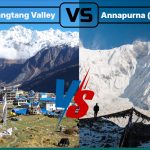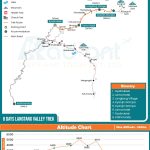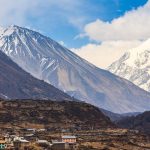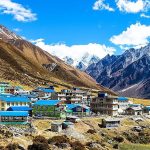A safe and unforgettable spring adventure, the Langtang Valley Trek in March is a meditative exploration of beauty and heritage in Nepal’s most accessible and enchanting destination.
This region, located north of Kathmandu in Langtang National Park, features diverse terrains from subtropical forests to high-alpine meadows. It is dominated by peaks like Langtang Lirung at 7,227 meters and Dorje Lakpa at 6,966 meters. And being here in March means capturing the trek’s transformative spirit.
You can see rhododendrons burst in pinks, reds and whites along the trails and they contrast with the patches of lingering snow on the summits. This creates a visual feast that is unique to this shoulder season.
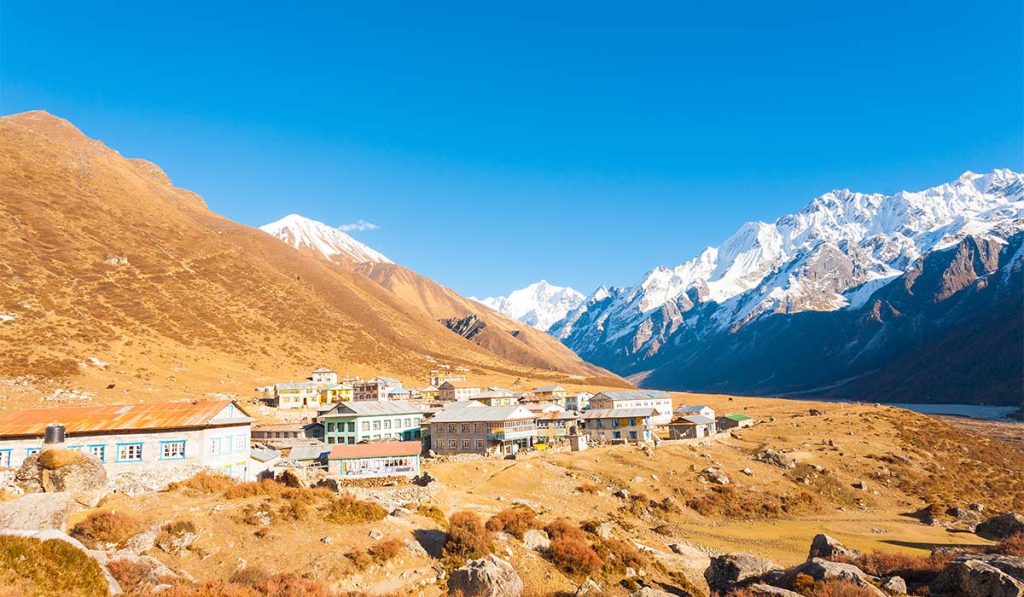
Likewise, the March weather is favorable for trekking, with daytime temperatures ranging between 10°C to 16°C at mid elevations. Expect a chilly morning and evening at higher points like Kyanjin Gompa.
In addition, the prevalence of clear skies offers unobstructed panoramic views. Minimal rainfall makes it safer and enjoyable as compared to winter’s harsh cold and monsoon’s mud.
Culturally, you can witness the resilient Tamang community even in the month of March. An interaction with them makes you realize that their Tibetan-influenced heritage shines through in rebuilt villages post the devastating 2015 earthquake.
You can interact with locals over butter tea or yak cheese in teahouses, witness early farming activities and soak in the quiet spirituality of Kyanjin Gompa monastery. And you can do so amid fewer crowds than the peak season of autumn. The trails showcase nature’s rebound as thawing glacial rivers like the Langtang Khola add a fresh flow.
Thus, the Langtang Valley Trek in March can be called more than a physical journey. It is an invigorating escape into Nepal’s Himalayas when spring’s arrival breathes new life into this ‘Valley of Glaciers’.
Highlights
- Forests glowing with pink and red rhododendrons, as the Langtang trails come alive with color in March
- Winter snow crowns the peaks while flowers bloom in the valleys and it reflects a beautiful mix of cold and new life
- Clear skies and mild weather make hiking easier and the mountain views even more breathtaking
- Chance to catch glimpses of red pandas or Himalayan tahrs as they reappear with the warmth of early spring
- March lets one breathe in the scent of wildflowers that blanket the trails, adding a fresh and colorful touch to the journey
- Opportunity to meet the Tamang people as they get ready for spring, sharing smiles and stories from their mountain life
- Kyanjin Gompa offers calm air and the hills around it begin to thaw, giving the monastery a peaceful and timeless feel
- Take in stunning views of Langtang Lirung and Dorje Lakpa as their white peaks shine above the green valley
Why Langtang Valley Trek in March
The Langtang Valley, located in Nepal’s Langtang National Park and a few hours from Kathmandu, is regarded as a premier trekking destination. The March Lantang Valley trek is ideal if you want to have an unforgettable experience. Here are the reasons on why you should be a part of the Langtang Valley Trek in March.

Natural Wonders
This place is often hailed as the ‘Valley of Glaciers’ as it features a stunning array of icy formations. It also comprises towering summits over 7,000 meters, including formidable Lantang Lirung at 7,227 meters. And the view gets even better in March.
Likewise, you can also see a rich mosaic of landscapes in this region. They include dense subtropical rhododendron forests to vast alpine meadows, all crisscrossed by pristine rivers. Add to that the trails dotted with sacred Buddhist sites.
Therefore, for those searching for the best time to trek Langtang, March stands out as an exceptional choice. After all, it blends accessibility with raw Himalayan allure.
Trek Favorable Time
March heralds the start of spring trekking in Langtang. As such, if you happen to be there in March, you can see the valley transform into a vibrant canvas of seasonal change. With temperatures moderating from winter’s chill, trekkers enjoy pleasant days. And that is possible under predominantly clear skies, ideal for capturing unobstructed views like that of Dorje Lakpa at an elevation of 6,966 meters. The spectacular view of the Ganesh Himal range.
And the crowning glory is rhododendron blooms, Nepal’s national flower, carpeting trails in brilliant hues of pink, red and white. It is a spectacle unique to early spring.
Suitable for Diverse Adventurers
The month of March appeals to a diverse range of adventurers. Experienced hikers can tackle the rewarding side of the ascents in the March Langtang Valley trek. Meanwhile, beginners can appreciate the moderate difficulty of the Langtang trek.
And the shorter itinerary of the Langtang Valley trek, as compared to the trek to Everest Base Camp or the Annapurna Base Camp trek, makes the journey simple and accessible.
Less Crowded
What sets March apart in Langtang trekking is its serene atmosphere. It is far less crowded than autumn peaks, allowing for deeper immersion in the awakening environment.
Unlike the potential for heavy snow in winter or monsoon’s slippery trails, March provides stable conditions. And that enhances safety and scenic enjoyment for the trekkers.
Weather and Climate Conditions in March
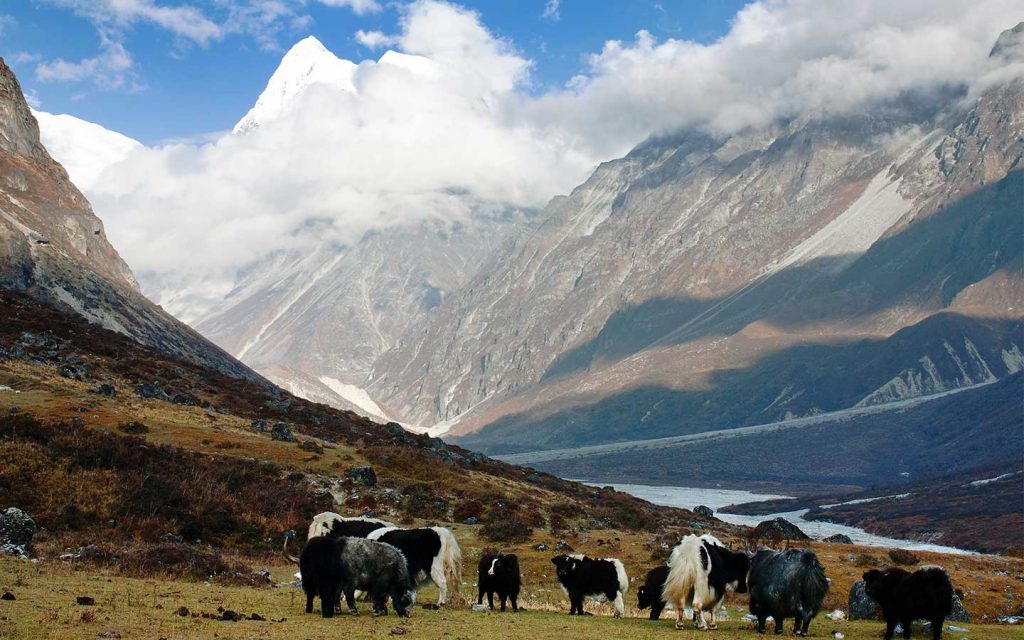
March Langtang trek means you are stepping into the region in early spring. And this time of the year brings a delightful shift toward milder conditions.
You can expect cool mornings and evenings that warm up into a comfortable afternoon. As such, these conditions are perfect for steady progress on the trails.
Likewise, the daytime temperatures average at 15°C to 20°C at starting points like Syabrubesi and nights are at 5°C to 10°C.
On the other hand, mid-elevations around Lama Hotel and Langtang Village see between 10°C and 16°C during the days and 0°C and 5°C at night. At higher elevations like Kyanjin Gompa or Tsergo Ri, expect 5°C to 12°C during the day and lows dipping to -5 to 0°C, especially early in the month.
In addition, the climate in Langtang in March boasts remarkable stability. As such, you can look forward to clear skies dominating the region. And the precipitation is also minimal, usually under 20mm. This means there is low humidity and the visibility is excellent.
Add to that the prevalence of light winds — they refresh your journey without any kind of hindrance. However, occasional flurries can dust the path. But rather than being an obstacle, this creates a magical blend of winter and spring.
If you are wondering about the perks of being in this region in March as compared to other times of the year, then avoiding the freezing risks of winter is one of them. Also, you do not need to deal with the monsoon’s downpours.
All these features of March make it one of the best times for the Langtang trek with safer and more vivid scenery. It means you can expect thawing snowfields, invigorating rivers and dry air that sharpens distant views.
Langtang Valley Route Conditions in March
Irrespective of the time of the year, you can opt for either the 8 Days Langtang Valley Trek or the 10 Days Langtang Valley Trek, depending on the trek package you choose. The eight-day itinerary below offers the general idea of the route you’ll follow during the trek.
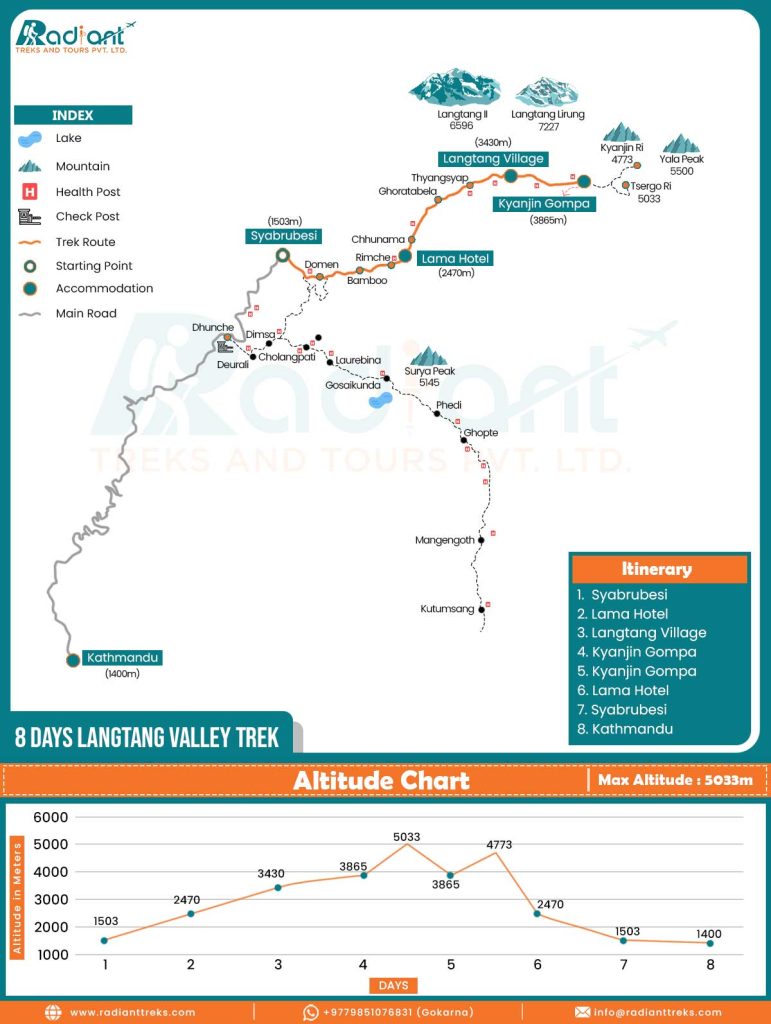
Outline Itinerary
- Day 01: Drive from Kathmandu to Syabrubesi (1,503 m / 4,931 ft), Distance: 120 km, Duration: 6 to 7 hours
- Day 02: Trek from Syabrubesi to Lama Hotel (2,470 m / 8,103 ft), Distance: 11 km, Duration: 5 to 6 hours
- Day 03: Trek from Lama Hotel to Langtang Village (3,430 m / 11,253 ft), Distance: 10 km, Duration: 6 to 7 hours
- Day 4: Trek from Langtang Village to Kyanjin Gompa (3,865 m / 12,680 ft), Distance: 9.7 km, Duration: 5 to 6 hours
- Day 05: Hike to Tsergo Ri (5,033 m / 16,512 ft) and return to Kyanjin Gompa (3,865 m / 12,680 ft), Distance: 9 km, Duration: 5 to 6 hours.
- Day 06: Hike to Kyanjin Ri (4,773 m / 15,659 ft), and trek to Lama Hotel (2,470 m / 8,103 ft), Distance: 21 km, Duration: 6 to 7 hours
- Day 07: Trek from Lama Hotel to Syabrubesi (1,503 m / 4,931 ft), Distance: 11 km, Duration: 5 to 6 hours.
- Day 08: Drive from Syabrubesi to Kathmandu, Distance 20 km, Duration 6 to 7 hours
But if you opt for the package of 10 days, the itinerary includes your arrival at the Tribhuvan International Airport and hotel transfer, along with the departure day on completion of the trek. Based on this itinerary, you can refer to the information below to get a picture of what the trek route of Langtang Valley is like in March.
Drive from Kathmandu to Syabrubesi: Getting into the Trailhead
Your Langtang Valley adventure begins with a long but beautiful drive from Kathmandu to Syabrubesi. It’s about 120 kilometers. Yet the mountain roads make the journey last around seven hours. Most travelers choose to go by jeep or bus. And this drive sets the tone for the adventure ahead.
In March, the lower hills are starting to get greener following winter. And you can see occasional glimpses of distant snow-capped peaks. You feel like they are teasing you about what’s to come ahead. And in early spring, the roads are generally dry and passable, avoiding the monsoon mudslides that plague later months.
Lower Valley Ascent: Forests and Riversides
The trek begins from Syabrubesi and the trail heads upstream along the Langtang Khola. You need to ascend gradually through lush pine and oak forests before arriving at Lama Hotel.
March transforms this section of the trail into a floral wonderland. That means you can see rhododendron trees, the national flowers of Nepal, beginning their blooms in hues of red and pink.
You move across the suspension bridges swaying over rushing rivers that are fed by thawing snow in March. Likewise, you pass small Tamang settlements where locals might be preparing fields for spring planting.
As you are hiking in March, you see that the terrain is mostly dry at these lower altitudes, but the crisp mornings can feel refreshing. And the sunlight seems to be filtering through the canopy to highlight wildflowers.
Mid-Valley Transitions: Villages and Culture
As you go deeper, the path levels out for a while before climbing toward Langtang Village. And the scenery also shifts from thick woodland to meadows. They are dotted with stone houses and prayer flags that can be seen fluttering in the March breeze.
With the receding snowline, this area feels particularly alive in March. As such, you can see patches of green grass where yaks start grazing. Add to that the clear weather that offers early peeks at towering peaks like Ganesh Himal.
Meanwhile, one of the highlights of this trek is the Langtang Village, which was rebuilt after the 2015 earthquake. You walk around this village or share tea with locals amid the budding spring energy to explore more about the area.
Above 3,000 meters, you might encounter light snow on shadier paths. Nonetheless, the stable conditions of March keep things safe and scenic and make this part of the route a reflective bridge between the lowlands and the high alpine world.
High Alpine Reaches: Glaciers and Monasteries
The route takes you to the upper valley at Kyanjin Gompa, one of the final destinations of the trek. Located at an elevation of 3,865 meters, the trek turns truly Himalayan at this point. That is so as it takes you along open pastures that give way to moraines and glacial views. And you can see the massive Langtang Lirung (7,227m) looming overhead.
March adds a layer of magic to this scenery. The air is dry and clear for unbeatable visibility. However, residual winter snow creates a striking contrast against the thawing ground, where hardy alpine shrubs begin to sprout.
This high point serves as a base for exploration, with the surrounding landscape feeling uncrowded in early spring. Also, there is a peaceful ambience as you are far from the busier autumn trails.
Summit Side Excursions: Panoramic Viewpoints
No Langtang trek is complete without venturing to the high point like Tsergo Ri, at an elevation of 5,033 meters. This ascent involves steeper switchbacks through rocky terrain, rewarding you with 360-degree panoramas of the Langtang range, Tibetan plateau glimpses, and distant Annapurna.
In March, this hike is especially rewarding yet challenging. That is so because the paths might have icy patches requiring careful steps. But the stable skies ensure sharp and sunlit views. And there is no haze of warmer months. Tsergo Ri, in particular, feels like a mini-summit triumph, with snow-capped ridges contrasting emerging green valleys below.
March Cultural Features
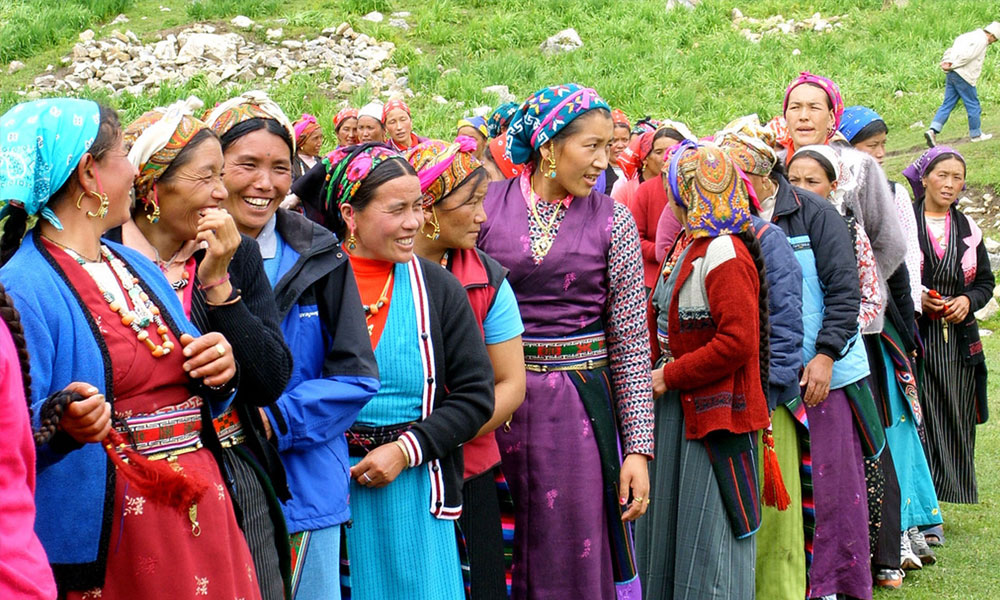
March showcases the cultural tapestry of Langtang by aligning trekking with local life and festivities.
The Tamang people, with Tibetan ties, populate the lower valleys. And their March activities, including preparing fields and herding, offer glimpses into daily life around Syabrubesi.
Meanwhile, the Sherpas live in the settlements at higher elevations. Here, you can try some fresh yak curd — a local favorite. As you enjoy it, you’ll see yaks grazing peacefully in the green pastures that have finally come to life after the long, harsh winter.
Likewise, the tranquility of Kyanjin Gompa in the month of March enhances meditative visits to the monastery. The monks’ chants resonate amid incense and the silence of spring.
Trek Difficulty and Required Fitness

The Langtang trek difficulty is rated moderate, which is why it is accessible for fit beginners. Daily hikes average 5 to 7 hours with steady elevation gains over 3,500 meters in total. As such, the trek promotes natural acclimatization.
And the March conditions add flavor. How so? The lower trails that tend to remain dry in March ease navigation. However, one may encounter icy spots above 3,500 meters and require vigilance from the trekkers. Therefore, one needs to remain fit to be a part of the Langtang Valley trek in March.
Fitness preparation for Langtang in March includes cardio training for endurance. You should opt for running or cycling. In a similar manner, improve the strength of legs via training like squats. Prior hikes build skills and strength to carry backpacks.
Meanwhile, the cooler and drier air of March is good in the sense that it minimizes fatigue. Yet it increases the need to drink water as there are chances you get dehydrated quickly due to dry air. Altitude sickness risks linger near highs; March’s stability aids, but rest at Kyanjin Gompa is wise.
Accommodation and Food in March
March marks the start of the trekking season in Langtang. As such, most teahouses along the trek route reopen in this month after the winter break. Add to that the availability of fresh local meals.
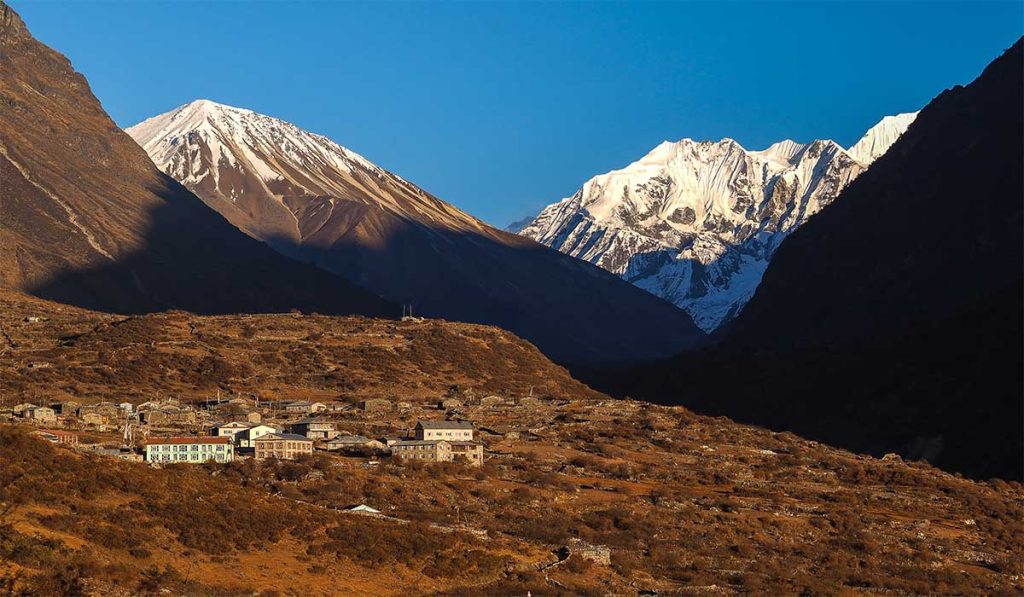
Accommodation
Teahouses along the Langtang Valley trek route in March are fully functional. And they are run by welcoming local families who offer simple but comfortable rooms. You’ll find wooden interiors, warm blankets and a stove in the dining hall to ward off the mountain chill. With fewer crowds than in April, it is not an issue to get a room in the teahouses in March. It is the case even at popular stops.
Food
Meals in March in this trekking trail are hearty and homemade. And they are perfect for battling cold evenings. Dal bhat remains the staple throughout the year. Expect soups, noodles and Tibetan bread as well. Fresh spring greens and local dairy, especially yak cheese and curd, add a seasonal touch.
In addition, facilities like hot showers and charging points are available even in March. But remember that these facilities are limited at higher altitudes.
Packing Essentials for March
Packing for the Langtang Valley Trek in March means being ready for both winter’s lingering chill and spring’s warmth. The weather can shift quickly and you are bound to face sunny afternoons along with cold and windy evenings. As such, you should wear and carry clothes in layers.

Clothing
- Carry moisture-wicking thermals as your base layer
- Add a warm fleece or wool sweater as the mid-layer
- Bring a good down jacket for evenings and higher altitudes
- Carry a lightweight and waterproof shell for occasional drizzle or mountain mist
- Stay cozy with comfortable trekking pants, warm gloves, a woolen hat and socks
Footwear and Accessories
- Pack broken-in and quality trekking boots that offer ankle support
- Bring gaiters and microspikes for extra grip in places with snow
- Don’t forget sunglasses and sunscreen to deal with the strong March sun at higher elevations
Sleeping and Gear
- Nights can drop below freezing, so a sleeping bag rated to -10°C is highly recommended
- Carry trekking poles for stability on uneven terrain
- A headlamp is essential if you need to start trekking early or in dimly lit tea houses
- Basic first-aid kit
- Water purification tablets or a filter bottle
FAQs

Why is March considered an appropriate month for the Langtang Valley trek?
The weather of March is mild, the skies are clear and the hillsides come alive with blooming rhododendrons. These features make the trails colorful and pleasant. As such, trekking becomes enjoyable and comfortable in March.
Will I see snow in March?
It is possible for you to come across patches of snow at higher altitudes in March in Langtang Valley. This is true especially near Kyanjin Gompa. It adds a touch of beauty to the landscape. And it doesn’t cause any difficulty while trekking in most cases.
Are the teahouses open in March?
Yes, most teahouses reopen after winter and are in full operation in March. You will find warm rooms, delicious meals and friendly hosts ready to welcome trekkers again.
How is the crowd like in the Langtang Valley trek route in March?
This month sees a moderate flow of trekkers in the region. As such, the route is lively but not overcrowded.
Is there a risk of altitude sickness in March?
Yes, altitude sickness can affect anyone above 2,500 meters, regardless of the season. Take your time, stay hydrated, and plan acclimatization stops along the way.

